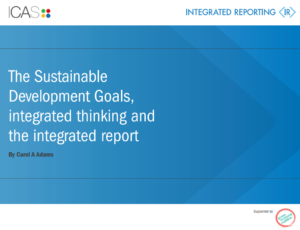Getting strategic about the value creation opportunity of the SDGs.

Sustainable development requires a systemic response involving transformative changes, notably in knowledge, policy and institutional systems from all sections of society. In fact, the SDGs are so complex and have so many moving parts that it’s fair to say that The SDGs cannot be achieved without collaboration between governments, private and public sector organizations and civil society organizations.
Since national governments are ultimately responsible for the achievement of the SDGs, it’s reasonable to expect that they should set expectations through legislation or soft regulation and holding organizations to account. In the area of changing how business operates, it would be welcomed if Stock Exchanges would use their influence over the private sector through the listing requirements that they set.
 Last month, the International Integrated Reporting Council (IIRC) and ICAS (the Institute of Chartered Accountants of Scotland), published this report which I authored titled, “The Sustainable Development Goals, integrated thinking and integrated reporting”. The report provides a 5 step framework for organisations to follow in order to integrate the SDGs into strategy and reporting.
Last month, the International Integrated Reporting Council (IIRC) and ICAS (the Institute of Chartered Accountants of Scotland), published this report which I authored titled, “The Sustainable Development Goals, integrated thinking and integrated reporting”. The report provides a 5 step framework for organisations to follow in order to integrate the SDGs into strategy and reporting.
The 5 Step Process for Value Creation:
1. Understand sustainable development issues relevant to the organization’s external environment;
The sustainable development issues that the SDGs address impact on the organization’s ability to create value for itself and its stakeholders. The Framework requires consideration of significant factors affecting the external environment and the organization’s response. These factors may increase or decrease value created either directly (e.g., by creating new business opportunities) or indirectly (e.g., through the quality of relationships with stakeholders or by influencing the availability, quality and affordability of a capital that the organization uses or affects). Therefore, consideration of the SDGs, and the sustainable development issues that they address, should be incorporated into the wider consideration of the external environment relevant to the organization’s ability to create value.
2. Identify material sustainable development issues that influence value creation
The materiality process for Integrated Reporting involves identifying, evaluating and prioritizing matters based on their ability to affect value creation in the short, medium and long term. Value is created for the organization and for others through increases, decreases and transformation of the capitals. Therefore, when planning their approach to the SDGs, organizations seeking to reassess their mission and purpose and/or to reduce corporate risk and increase opportunities arising from sustainable development issues should identify, evaluate and prioritize which sustainable development issues maximize outcomes for the six capitals and hence their
contribution to the SDG targets.
3. Develop strategy to contribute to the SDGs through the business model
The organization’s strategy identifies how it intends to mitigate or manage risks and maximize opportunities. Organizations should set out their strategic objectives and strategies to support relevant and significant SDGs through their business model. This should incorporate resource allocation plans and specific, quantified short,
medium and long-term targets.
4. Develop integrated thinking, connectivity and governance
The Framework calls on organizations to link their strategy to changes in the external environment including evolving societal expectations and natural resource limitations. Further, it emphasizes the importance of responding to the legitimate needs and interests of stakeholders because value is created through its relationships with others. It recognizes that these interests can be in conflict and may require trade-offs. Those charged with governance are required to acknowledge their involvement and responsibility for this process. Those charged with an organization’s governance should satisfy themselves that: l the processes of building relationships with stakeholders will:
- identify material sustainable development issues; that these are incorporated into strategy; and, that appropriate goals and targets have been developed.
- the organization develops and nurtures relationships with and between stakeholders in order to enhance collective well-being;
- the organization’s business model considers all material sustainable development issues impacting on inputs and outcomes in terms of the six capitals;
- the organization’s strategy and business model evolve to reflect past performance with respect to the SDGs.
5. Prepare the integrated report
Organizations should report on key sustainable development issues which impact on stakeholders and the organization to influence value creation in the short, medium and long term. Organizations should report their contribution to SDG targets alongside their outcomes with respect to the six capitals.
To read the full report please click here
_______________________
Carol Adams is an author, consultant and Non-Executive Director with expertise in financial and non-financial reporting and environmental, social and governance risks. To learn more about Carol please visit her website or follow her on twitter.
